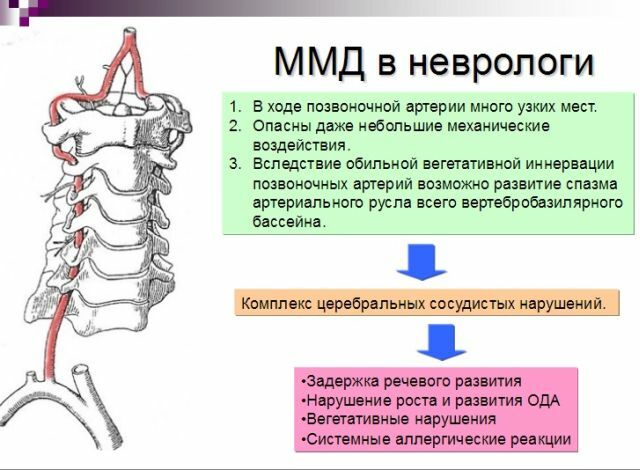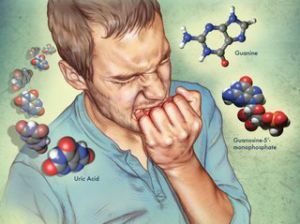 Lesch-Nihan syndrome is a hereditary disease, which is manifested by an increase in the synthesis of uric acid. This is due to a deficiency of the enzyme hypoxatin-guanine phosphoribosyltransferase.
Lesch-Nihan syndrome is a hereditary disease, which is manifested by an increase in the synthesis of uric acid. This is due to a deficiency of the enzyme hypoxatin-guanine phosphoribosyltransferase.
This disease is observed in men and is most often expressed as a slowing down of psychomotor development, neurological abnormalities and metabolic disorders.
What is the reason, what is the type of inheritance?
Women are carriers of this genetic disorder, which is inherited, but they themselves do not suffer.
The average life expectancy of people with Lesha Nayhan syndrome is thirty years. The frequency of variations in the manifestation of this syndrome is unknown. To date, more than 600 cases of reversion of the GFRT gene are known.
The main cause of the syndrome is the absence of hypoxanthine-guanine phosphoribosyltransferase. Because of this, pyrolysis( decomposition) and excretion of purines in the form of uric acid occur. To compensate for the loss of purines, they are accelerated biosynthesis.
The speed of purine biosynthesis exceeds the rate of their decomposition, which leads to the production of excessive amounts of uric acid. The plasma of blood is oversaturated with sodium urates, which eventually crystallize in various tissues and organs, forming tofuys( gouty formations).
When the crystals migrate to the joints, arthritis and inflammation immediately appear. The appearance of the syndrome can also lead to the presence of sand and kidney stones that block the excretion of urine and cause infection and hematuria.
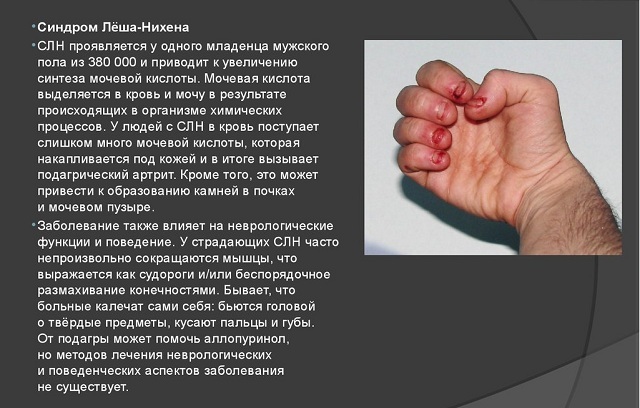
Clinical picture
The disease begins to progress even in infancy and manifests itself by symptoms such as: acute reflex excitability, the child's disposition to self-harm( therefore the disease is also called self-cannibalism syndrome), muscular hypertonia, oligophrenia.
Due to the manifestation of all of the above symptoms, sometimes infants are mistakenly diagnosed with cerebral palsy. In general, the symptoms of Lesch Nihan syndrome are classified into certain groups( triad of symptoms):
- Incorrect metabolism - multiple urination, thirst, later sexual formation, growth retardation, arthritis, crystalluria.
- Untypical behavior of - sudden mood changes, aggravated aggressiveness towards oneself, trauma to the body.
- Degradation of the nervous system - frequent causeless vomiting, hypertension of muscles, hyperkinesis, convulsive alertness, physical and mental retardation, paralysis of upper or lower extremities, dysarthria.
At the beginning of the development of the disease, psychomotor retardation is observed, with the further development of muscle hypertonicity. After teething, patients develop a tendency to self-healing.
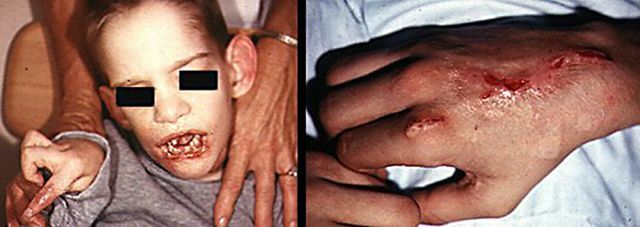
In the photo, a self-cannibal boy is a common occurrence in Lesha Nihan's syndrome.
There is also an autoaggression, in which patients bite their fingers, nails, lips and scratch their faces to the blood. Patients may be aggressive not only to themselves, but also to humans, animals, etc. The patient's pain sensitivity remains unchanged, so self-harm is accompanied by cries from pain caused to oneself.
The type of Lesch-Nichin syndrome depends on the degree of activity of the hypoxanthine-guanine phosphoribosyltransferase enzyme.
The development of the syndrome can lead to such consequences:
- development of many neurological and psychiatric disorders leading to poor social adaptation;
- development of such infectious complications, as: infectious-inflammatory disease of kidneys and pyelonephritis;
- reduced life expectancy.
Diagnostic criteria and methods
The diagnosis of Lesch-Nihan syndrome is based on the manifestation of such clinical elements:
- neurological dysfunction;
- cognitive and behavioral disorders;
- increased production of uric acid.
To determine the presence of the syndrome at an early stage of its development is almost impossible, since all of the above signs are not immediately apparent. To diagnose this disease, first of all, biochemical studies are conducted that determine changes in the metabolism of purines:
- an increase in the amount of uric acid in urine and blood;

- nitrogen retention( with the advanced stage of the disease, chronic nephritis is diagnosed).
Also conducted such hematological studies:
- Puncture of bone marrow .Shows the number of medulloblast.
- Hemoleukogram .Determines the presence of megaloblastic anemia.
The physical development level of the patient is inspected. At such check scars, scars, traces of traumas very often are found out. Patients are noted inappropriate behavior, which develops into aggression to themselves and to other people and objects.
To confirm the diagnosis, the delivery of blood and urine tests is assigned. Ultrasonography of the kidneys is also performed. To accurately confirm the diagnosis, a genetic study is performed that determines the level of GFUR and the recognition of the mutations of its gene.
What modern medicine offers
When diagnosing Lesha-Nihan syndrome, the following treatment methods are used:
- Reducing the amount of uric acid .In this case, medications are prescribed that are able to lower the level of uric acid in the blood and most often it is Allopurinol. The average daily dose of this drug is 100 - 300 mg. Therapy should be started from a dose of 100 mg per day, after which it is increased to 600 mg. In the presence of severe kidney and liver diseases,
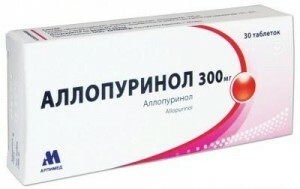 this drug is not prescribed. In case of intolerance to Allopurinol, a probenicid is given, with the frequency of administration twice a day( 250 mg at a time).
this drug is not prescribed. In case of intolerance to Allopurinol, a probenicid is given, with the frequency of administration twice a day( 250 mg at a time). - Conduction of symptomatic therapy for neurological disorders of , based on the manifestation of a symptom.
- Operative and medicamentous removal of kidney stones .
- Purpose of non-steroidal anti-inflammatory drugs , in case of joint inflammation.
- Also, patients are assigned reception of balanced mixtures of salts of ( Polycitra), which maintain urine pH at level 7. Thus, the time of lysis of uric acid is accelerated. Medicinal therapy is combined with a non-purine diet. It is necessary to drink plenty of clean water.
- For the relief of the manifestations of depression of , patients are prescribed Alprazolam or other similar medications. As a result, patients feel less anxious and anxious and stabilizes their emotional state.
Forecast and consequences of
The average life expectancy of patients with this syndrome is 30-40 years. Most patients die from aspiration pneumonia or from deterioration in chronic renal stone diseases and kidney deficiency. Also, a significant number of patients die unexpectedly, for unknown reasons.
In some cases, doctors diagnose neglected forms of kidney stone diseases. It is also possible to develop rapid dysphagia and death from pneumonia and aspiration. The cause of death can also be complications after calculous pyelonephritis.


